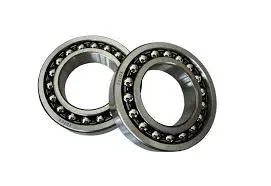
नोव्हेंबर . 07, 2024 09:53 Back to list
Single Row Roller Bearings for Efficient Load Distribution and Performance Optimization
Understanding Single Row Roller Bearings
Single row roller bearings are essential components in many mechanical systems, providing support and reducing friction between moving parts. These bearings are designed to handle radial loads, making them crucial in various applications across different industries such as automotive, aerospace, and manufacturing. This article delves into the key characteristics, advantages, applications, and maintenance considerations of single row roller bearings.
Characteristics of Single Row Roller Bearings
Single row roller bearings consist of cylindrical rollers that are oriented parallel to the axis of rotation. These rollers are separated by a cage, which maintains spacing and minimizes friction between them. The primary characteristics of single row roller bearings include
1. Load Capacity Due to their unique design, single row roller bearings can handle a higher radial load compared to traditional ball bearings. The large contact area between the rollers and the raceway allows them to distribute loads more effectively.
2. Orientation These bearings typically have a linear design, making them more suitable for applications where axial displacement is either absent or minimal. They excel in applications where a high degree of stiffness and stability is required.
3. Varieties While the basic design of single row roller bearings remains consistent, they come in various forms, such as tapered, cylindrical, and spherical roller bearings. Each type is optimized for specific load dynamics and operational requirements.
Advantages of Single Row Roller Bearings
Single row roller bearings offer a range of advantages that make them a preferred choice in many engineering applications
1. Enhanced Load Distribution The configuration of cylindrical rollers allows for better weight distribution and enhanced load-handling capabilities. This is particularly beneficial in heavy-duty applications.
2. Lower Friction The reduced contact area between rollers and raceways minimizes friction, leading to improved efficiency and longer service life. This results in lower energy consumption, an essential factor in both design and operational phases.
3. Durability Constructed from high-quality materials such as steel or ceramic, single row roller bearings are designed to withstand harsh operating conditions, including high temperatures and corrosive environments. Their robust nature ensures they can operate reliably over extended periods.
4. Reduced Maintenance In applications where continuous operation is critical, the maintenance requirements for single row roller bearings are typically lower compared to other bearing types. Their durability and lower wear rates prolong intervals between necessary inspections and replacements.
single row roller bearing

Applications of Single Row Roller Bearings
These bearings find extensive use in a variety of applications. Some notable examples include
1. Automotive Engineering Single row roller bearings are commonly used in wheel hubs, transmission systems, and drivetrain components. Their ability to handle heavy loads makes them ideal for vehicles experiencing significant stress.
2. Industrial Machinery In manufacturing equipment such as conveyor systems and processing machinery, these bearings are often utilized due to their reliability and efficiency in high-load scenarios.
3. Aerospace Applications The aerospace industry demands components that can withstand extreme loads and environmental conditions. Single row roller bearings are employed in aircraft systems to ensure safe and efficient operations.
4. Marine Equipment Given their corrosion-resistant options, these bearings are suitable for marine applications, where exposure to water and salt can degrade other bearing types.
Maintenance Considerations
While single row roller bearings are designed for durability, maintenance remains crucial to ensure optimal performance. Key maintenance practices include
1. Regular Inspections Frequent checks for signs of wear or damage can prevent unexpected failures and prolong the lifetime of the bearings.
2. Lubrication Proper lubrication is essential for reducing friction and preventing overheating. It is important to follow manufacturer guidelines regarding lubrication intervals and types of lubricant.
3. Proper Installation Ensuring correct installation is vital. Misalignment can lead to premature wear or failure, negating the advantages of using high-quality bearings.
In conclusion, single row roller bearings play a vital role in modern machinery and equipment, offering excellent load capacity, efficiency, and durability. Understanding their characteristics, advantages, applications, and maintenance needs is essential for engineers and manufacturers seeking reliable solutions in their designs. With proper care, these bearings can significantly enhance the performance and longevity of mechanical systems across various industries.
Latest news
-
Grooved Ball Bearing Design and Functionality
NewsJun.04,2025
-
Concrete Mixer Bearing Load Capacity Testing
NewsJun.04,2025
-
6004 Bearing Dimensions in Robotic Joint Designs
NewsJun.04,2025
-
Advantages of Single-Row Deep Groove Ball Bearings
NewsJun.04,2025
-
Applications of Deep Groove Ball Bearings in Automotive Systems
NewsJun.04,2025
-
Innovations in Bearing Pressing Machine Design
NewsJun.04,2025
